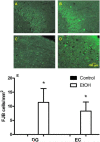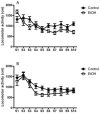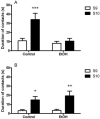Reversibility of object recognition but not spatial memory impairment following binge-like alcohol exposure in rats
- PMID: 20849966
- PMCID: PMC2975859
- DOI: 10.1016/j.nlm.2010.09.006
Reversibility of object recognition but not spatial memory impairment following binge-like alcohol exposure in rats
Abstract
Excessive alcohol use leads to neurodegeneration in several brain structures including the hippocampal dentate gyrus and the entorhinal cortex. Cognitive deficits that result are among the most insidious and debilitating consequences of alcoholism. The object exploration task (OET) provides a sensitive measurement of spatial memory impairment induced by hippocampal and cortical damage. In this study, we examine whether the observed neurotoxicity produced by a 4-day binge ethanol treatment results in long-term memory impairment by observing the time course of reactions to spatial change (object configuration) and non-spatial change (object recognition). Wistar rats were assessed for their abilities to detect spatial configuration in the OET at 1 week and 10 weeks following the ethanol treatment, in which ethanol groups received 9-15 g/kg/day and achieved blood alcohol levels over 300 mg/dl. At 1 week, results indicated that the binge alcohol treatment produced impairment in both spatial memory and non-spatial object recognition performance. Unlike the controls, ethanol treated rats did not increase the duration or number of contacts with the displaced object in the spatial memory task, nor did they increase the duration of contacts with the novel object in the object recognition task. After 10 weeks, spatial memory remained impaired in the ethanol treated rats but object recognition ability was recovered. Our data suggest that episodes of binge-like alcohol exposure result in long-term and possibly permanent impairments in memory for the configuration of objects during exploration, whereas the ability to detect non-spatial changes is only temporarily affected.
Copyright © 2010 Elsevier Inc. All rights reserved.
Figures






Similar articles
-
Determinants of novel object and location recognition during development.Behav Brain Res. 2013 Nov 1;256:140-50. doi: 10.1016/j.bbr.2013.07.055. Epub 2013 Aug 8. Behav Brain Res. 2013. PMID: 23933466 Free PMC article.
-
Activated microglia are implicated in cognitive deficits, neuronal death, and successful recovery following intermittent ethanol exposure.Behav Brain Res. 2013 Jan 1;236(1):270-282. doi: 10.1016/j.bbr.2012.08.052. Epub 2012 Sep 5. Behav Brain Res. 2013. PMID: 22985845
-
Moderate prenatal alcohol exposure impairs performance by adult male rats in an object-place paired-associate task.Behav Brain Res. 2019 Mar 15;360:228-234. doi: 10.1016/j.bbr.2018.12.014. Epub 2018 Dec 7. Behav Brain Res. 2019. PMID: 30529401 Free PMC article.
-
A 5-month period of epilepsy impairs spatial memory, decreases anxiety, but spares object recognition in the lithium-pilocarpine model in adult rats.Epilepsia. 2005 Apr;46(4):499-508. doi: 10.1111/j.0013-9580.2005.38704.x. Epilepsia. 2005. PMID: 15816943
-
Alcohol-related amnesia and dementia: animal models have revealed the contributions of different etiological factors on neuropathology, neurochemical dysfunction and cognitive impairment.Neurobiol Learn Mem. 2011 Nov;96(4):596-608. doi: 10.1016/j.nlm.2011.01.003. Epub 2011 Jan 21. Neurobiol Learn Mem. 2011. PMID: 21256970 Free PMC article. Review.
Cited by
-
Persistent negative effects of alcohol drinking on aspects of novelty-directed behavior in male rhesus macaques.Alcohol. 2017 Sep;63:19-26. doi: 10.1016/j.alcohol.2017.03.002. Epub 2017 Jun 23. Alcohol. 2017. PMID: 28847378 Free PMC article.
-
The Interplay between the Hippocampus and Amygdala in Regulating Aberrant Hippocampal Neurogenesis during Protracted Abstinence from Alcohol Dependence.Front Psychiatry. 2013 Jun 27;4:61. doi: 10.3389/fpsyt.2013.00061. Print 2013. Front Psychiatry. 2013. PMID: 23818882 Free PMC article.
-
Pharmacological blockade of corticotropin-releasing hormone receptor 1 (CRH1R) reduces voluntary consumption of high alcohol concentrations in non-dependent Wistar rats.Pharmacol Biochem Behav. 2012 Jan;100(3):522-9. doi: 10.1016/j.pbb.2011.10.016. Epub 2011 Oct 20. Pharmacol Biochem Behav. 2012. PMID: 22036774 Free PMC article.
-
The long-term cognitive consequences of adolescent exposure to recreational drugs of abuse.Learn Mem. 2018 Aug 16;25(9):481-491. doi: 10.1101/lm.046672.117. Print 2018 Sep. Learn Mem. 2018. PMID: 30115770 Free PMC article. Review.
-
Binge-like ethanol consumption increases corticosterone levels and neurodegneration whereas occupancy of type II glucocorticoid receptors with mifepristone is neuroprotective.Addict Biol. 2014 Jan;19(1):27-36. doi: 10.1111/j.1369-1600.2012.00451.x. Epub 2012 Apr 13. Addict Biol. 2014. PMID: 22500955 Free PMC article.
References
-
- Aggleton JP, Vann SD, Oswald CJ, Good M. Identifying cortical inputs to the rat hippocampus that subserve allocentric spatial processes: a simple problem with a complex answer. Hippocampus. 2000;10:466–474. - PubMed
-
- Assuncao M, Santos-Marques MJ, De Freitas V, Carvalho F, Andrade JP, Lukoyanov NV, Paula-Barbosa MM. Red wine antioxidants protect hippocampal neurons against ethanol-induced damage: A biochemical, morphological and behavioral study. Neuroscience. 2007;146:1581–1592. - PubMed
-
- Bannerman DM, Yee BK, Lemaire M, Wilbrecht L, Jarrard L, Iversen SD, Rawlins JN, Good MA. The role of the entorhinal cortex in two forms of spatial learning and memory. Experimental Brain Research. 2001;141:281–303. - PubMed
-
- Bonthius DJ, West JR. Alcohol-Induced Neuronal Loss in Developing Rats - Increased Brain-Damage with Binge Exposure. Alcoholism-Clinical and Experimental Research. 1990;14:107–118. - PubMed
-
- Bowden SC, Mccarter RJ. Spatial Memory in Alcohol-Dependent Subjects - Using A Push-Button Maze to Test the Principle of Equiavailability. Brain and Cognition. 1993;22:51–62. - PubMed
Publication types
MeSH terms
Substances
Grants and funding
LinkOut - more resources
Full Text Sources

